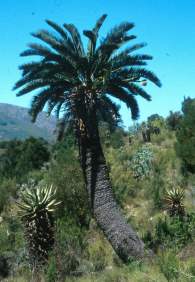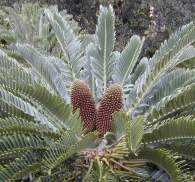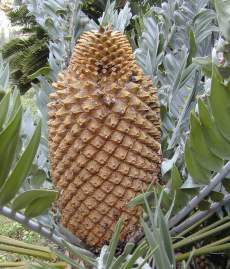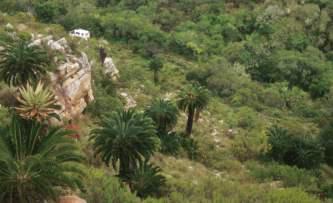Encephalartos longifolius
Encephalartos longifolius (Jacq.) Lehm.
Family: Zamiaceae
Common names: Thunberg's cycad, Suurberg cycad (Eng.); Suurbergbroodboom (Afr.)
SA Tree No: 9
Introduction
Encephalartos longifolius and E. caffer were the first cycads to be scientifically recorded in South Africa as long ago as 1772. During a trip to the Eastern Cape, Swedish botanist, Carl Peter Thunberg, accompanied by Francis Masson, came across E. longifolius growing in the Langkloof.

Description
Description
The stems, which are mostly erect, can reach a height of 4.5 m. Branching rarely occurs, but up to 10 stems may originate from the base.
The young leaves are covered in fine hairs that disappear later. The leaves are 1-2 m in length and are mostly glossy and dark green. The last third of the leaf curves strongly downwards giving the crown a relatively compact umbrella shape. The leaflets may be moderately spaced, but can sometimes overlap and they can be up to 200 mm long. The edges of the leaflets are normally smooth but can sometimes have 1-3 teeth on the lower margin. The tip terminates in a sharp spine or it can be rounded.

Encephalartos longifolius cones are very large and are of the heaviest of all the South African cycads, with female cones weighing up to 36 kg. The male plants bear up to 3 greenish brown cones that are 400-600 x 150-200 mm. The females bear 1 (rarely 2) olive-green cones that are 500-600 x 400 mm.

Conservation Status
Status
As with all South African cycads, this species is classified under Appendix I of the CITES Convention. Appendix I includes all species threatened with extinction that are, or may be affected by trade. Trade in these species is subject to particularly strict regulations and is only authorized in exceptional circumstances. See www.cites.org. The main threat to this species is the illegal collecting of specimens from the wild. Fortunately many populations of Encephalartos longifolius occur in protected areas. Specimens are present in the Baviaanskloof Conservation Area, the Groendal Wilderness Area, the Longmore State Forest and in the Addo Elephant Park (Zuurberg).
Distribution and habitat
Distribution description
Encephalartos longifolius is widely distributed in the southwestern parts of the Eastern Cape. The distribution starts west of Joubertina in the Kouga Mountains and continues along the Kouga and Suuranys Mountains. The plants also occur in the eastern parts of the Baviaanskloof Mountains, the Elandsberg and parts of the Groot Winterhoek Mountains. Here the continuity stops and continues further to the north in the Klein Winterhoek Mountains, the Zuurberg, and further east to the Grahamstown District. E. longifolius and E. lehmannii are the westernmost cycads in South Africa and their distributions do overlap slightly.

This cycad occurs in a variety of habitats with large differences in soil and climate. In some areas west of Port Elizabeth, plants grow in acid sands with fynbos vegetation, whereas in the Zuurberg they occur in grasslands. Near Kirkwood and in the Paardepoort (Klein Winterhoek Mountains), plants grow in succulent thicket vegetation. They occur at altitudes of between 200 and 1500 m above sea level. The annual rainfall in its distribution area varies from 300 to 1250 mm.
Derivation of name and historical aspects
History
Thunberg's cycad is one of the 37 species of Encephalartos that occur in South Africa. The genus Encephalartos occurs only on the African continent and there are 68 species. Thunberg originally described this plant as Cycas caffra in 1775, basing his description on specimens of E. longifolius and E. caffer, as he was under the impression that the latter was a juvenile form. In 1800 he renamed it Zamia caffra. In 1801 N.J. Jacquin decided that two species were involved and the larger plant was named Zamia longifolia. Then in 1834, J.G.C. Lehmann transferred Zamia longifolia to the genus Encephalartos and the plant became Encephalartos longifolius.
Most cycads contain toxic compounds within their tissues. The seeds are especially toxic. A well-known case of human poisoning occurred in South Africa during the Anglo-Boer war of 1899-1902. General Jan Smuts and his commando were camped in the Zuurberg and besieged by British troops. With stocks of food running low, some of the men decided to sample the cycad seeds with disastrous results. Very soon they were all in agony as the poison took effect. By morning most had recovered and they were able to march deeper into the mountains.
Ecology
Ecology
For a long time it was assumed that all cycads were wind pollinated, but research in the last decade has shown that in many cases, species-specific beetles pollinate these plants. While it has not been conclusively shown that beetles pollinate Encephalartos longifolius, pollinating beetles have been found on the cones of wild plants.
Cones are produced between April and June and the seed is shed between October and December. Baboons, hornbills or small rodents are the dispersal agents as they feed on the fleshy covering of the seeds. Presumably they have some mechanism to counteract the effect of the toxins.
Uses
Use
Cycads are favoured garden plants and there is a demand for large plants. As most cycad species are slow growers this has led to the indiscriminate removal of plants from the wild and brought many populations to the brink of extinction. Fortunately Encephalartos longifolius is still well represented in the wild and cycad nurseries are making cultivated plants available for the horticultural trade.
In the past, the stems of cycads were used as a food source by the local inhabitants of the time. The pith of the stem was scooped out and buried to allow it to ferment for a while. This process possibly ensured that the toxins were broken down. This pulp was then dried and ground into a flour, used to produce cakes that were fire baked.
Growing Encephalartos longifolius
Grow
Encephalartos longifolius is suitable for container planting and is a great feature plant in a garden. It is suited to temperate and cool subtropical regions. Mature plants prefer full sun and they may tolerate light frosts. They prefer a moderately acid, well-drained sandy-loam soil. Do not over-water as most cycads are susceptible to root rot. This can spread to the rest of the plant if it is not stopped in time. Cycads require regular feeding with a balanced inorganic fertilizer. Mulching with compost or manure will improve soil condition and add extra nutrition.
Seed can be propagated in spring in seedling trays filled with clean river sand and kept in an area where temperatures of between 25-28°C are maintained. Remove the fleshy outer layer from the seed by soaking in water for a few days. Rub off this layer and let the seeds dry. Use gloves during this process as this soft layer contains toxins. Germination takes place over 3-6 months, after which the seedlings should be carefully removed and planted in plastic growing bags filled with a well-drained medium. When they are large enough (approximately 2 years), plant in large pots or in the garden.
Mealy bugs and scale are the main pests of cycads in cultivation but they can be controlled with a systemic insecticide. Cycad cones attract snout beetles that often destroy the seeds. Spray the cones with a contact insecticide if these beetles are noticed. It is recommended that a contact insecticide be applied regularly when new leaves are noticed as a tiny gall midge favours the newly emerging leaves and can destroy them
Recipe for a suitable growing medium:
- 4 shovels clean, coarse, river sand
- 4 shovels milled pine bark
- 2.5 shovels loam
- 40 g dolomite or dolomitic lime
- 3 g iron sulphate
- Include a balanced, slow-release fertilizer at the rate stipulated on the product.
References
- Cycad Society of South Africa, 2001-2006, Species pages, http://www.cycadsociety.org/species_list.html
- Donaldson, J. & Winter, J. 2002. Grow cycads . Kirstenbosch Gardening Series. National Botanical Institute, Cape Town.
- Goode, D. 2001. Cycads of Africa , vol.1. D&ECycads of Africa, Gallomanor.
- Grobbelaar, N. 2002. Cycads-with special reference to the southern African species . Published by the author, Pretoria.
- Jones, D.L. 2002. Cycads of the World. Smithsonian Institution Press, Washington DC .
- Kemp, M. 1985. Focus on Encephalartos longifolius. Encephalartos 1: 6-13.
- Van Wyk, B-E., Van Heerden, F. & Van Oudtshoorn, B. 2002. Poisonous plants of southern Africa . Briza Publications, Pretoria.
- Von Breitenbach, F. & Von Breitenbach, J. 1992. Tree atlas of southern Africa . Dendrological Foundation, Pretoria.
Credits
De Wet Bösenberg
Kirstenbosch Research Centre
June 2006
Plant Attributes:
Plant Type: Tree
SA Distribution: Eastern Cape
Soil type:
Flowering season:
PH:
Flower colour:
Aspect: Full Sun, Morning Sun (Semi Shade), Afternoon Sun (Semi Shade)
Gardening skill: Average
Special Features:
Horticultural zones










Rate this article
Article well written and informative
Rate this plant
Is this an interesting plant?
Login to add your Comment
Back to topNot registered yet? Click here to register.